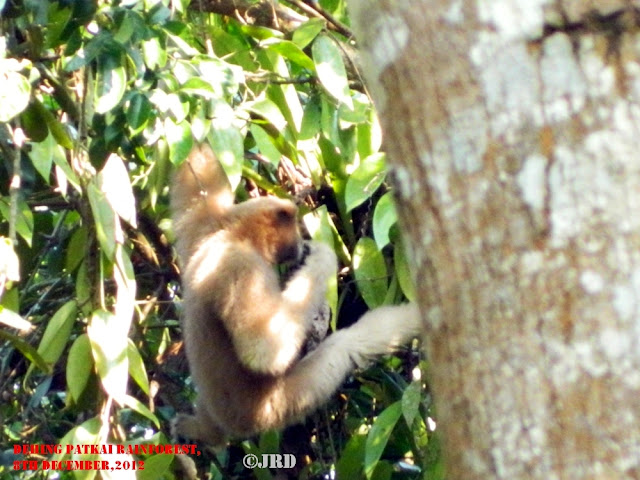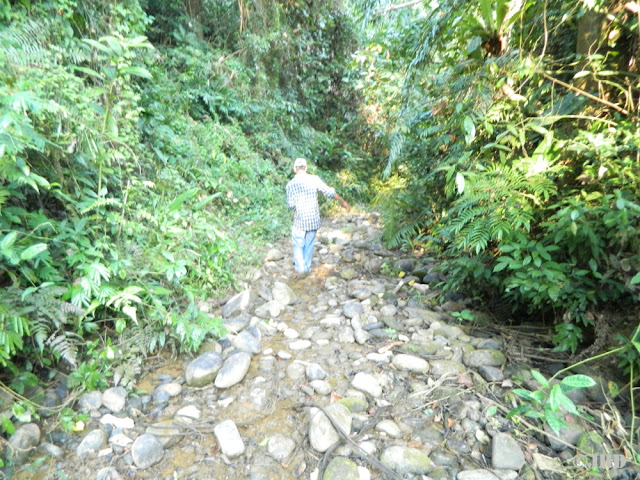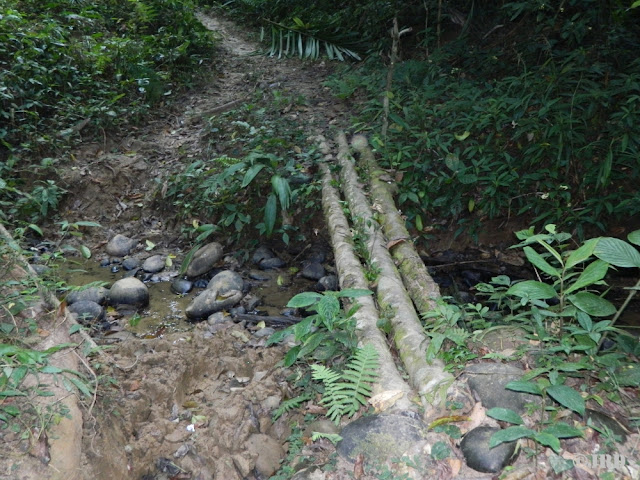On the Nature's Trail. Dehing Patkai Rain Forest :
An extraordinary day in the lap of nature. On 8th December, 2012
~~~~~~~~~~~~~~~~~~~~~~~~~~~~~~~~~~~~~~~~~~~~~~~~~~~~~~~~~~~~~~~~~~~~~~~~~~~~
I started from my in-laws' house from Sivasagar at around 5.20 am to get a taste of a virgin rain forest of Assam, Dehing Patkai, situated at Dibrugarh District of Assam. The road was very scenic and amidst the green cover of Tea Gardens of Upper Assam. Hit the road with my good old Alto, no one else to accompany me till I reach Naharkatia, a town near the rainforest and an important business hub of Dibrugarh District of Assam. The car was responding very well and I have enjoyed the morning atmosphere on a sleepy misty morning of Saturday along the NH 37. Burned rubber at my will in some places as the road was good but at some areas the road was blanketed by thick fog and I had to drive in a very cautious manner. I stopped just after crossing the Sivasagar town to take few shots of the road and to feel the misty morning in the midst of tea gardens.
Reached Naharkatiya Town after driving for around 85 kms and already I was feeling a little bit of excitement thinking of the day ahead. Met my other fellow tracking partners for the day, Mr. Prasenjit Karmakar, Mr. Mridupaban Phukan and Mr. Debojit Sonowal. Mr. Phukan is an experienced wildlife conservationist, an eminent bird watcher and writer. I just mesmerized by his deep knowledge of the Bio-diversity of the region and his passion for the wildlife. Mr. Debojit Sonowal, a reporter who is the regional correspondent of Assamese daily. He is a nature photographer with a warm heart for the nature. Mr. Prasenjit Karmakar, an educational entrepreneur from Naharkatiya who have developed a public library in Naharkatiya having more than 10000 books with a facility with reading rooms, resource centre, internet connectivity etc.
 |
| The Road |
 |
| We spotted the Capped Langurs here. |
Started the journey to the lap of the nature from the hassle bustle of polluted city life. Just after 5 kilometers we have reached the Joypur Range of Dehing Patkai Sanctuary. A thick green cover of trees had welcomed us to this rain forest. The road was in dilapidated condition although it was a connecting road to places like Deomali, Khunsa of Arunachal Pradesh. But my 7 years old Alto did managed to maneuver at the patchy and bumpy road effortlessly. The morning was quiet and a mesmerizing silence had engulfed us, the chirps of the birds welcomed us and all we knew that we are at their territory. On the left side of the road was the rain forest and on the other side of the road was paddy cultivation. Mr. Phukan informed us about this specific region, the paddy field is at just near the forest and so herds of elephants always comes from the forest to the paddy field. This is a very big problem for the villagers. The forest department had come up with the idea of power fencing the entire stretch of the paddy field and successfully installed solar powered fencing to protect the crops. I have seen many fenced areas are open may be due to lack of maintenance and I was informed that the entire project is no more functioning.
 |
| The Forest starts from here.. Near Burhidining River. |
Around 8.30 we were inside the forest. Mr. Phukan advised us to stop for a moment and all of us were greeted with the eerie silence of the jungle. And suddenly we were greeted with the chirps of birds just enjoying their territory. I tried to click some pics but the birds were very smart to dupe my 20x Zoom PS. I did managed to click a few shots but Debojit and Mr. Phukon got some very interesting shots.Mr. Phukon also showed some elephant trails and foot mark of elephants. There was a place which have a very unique nature in the soil of the place. The soil contains salt and minerals which attracts elephants and that place is frequently visited by herds of elephants to feast on the salted soils. The place is just near the road and the side of the road is damaged by the elephants.
 |
| Capped Langur |
 |
| From Right -Mr. Karmakar, Mr. Debojit and Mr. Phukan |
We again started our journey through the road enjoying the green cover of the forest and suddenly Mr. Karmakar had seen some movements and told us that he had seen some monkeys at a distance. We got down and Mr. Phukan told us that these are capped langurs. Wow ! Just after 30 minutes of entering the jungle we have seen a herd of rare species of Capped Langurs. The Langurs were munching seeds and fruits from the trees and watching our movements. This is an endangered species and their population is declining drastically. It was a treat to watch the Langurs in the branches atop the tall tress. Their sounds echoed in the forest and a thrilling feel gutted all of us. We spent some times with the sight of the capped langurs and started our journey though the broken road.
We got down near a bridge for another glimpse of the nature. There is a small rivulet passing through the road and the scenery was really breathtaking. There is a concrete bridge over the rivulet and a small cute temple near the road. We stopped there for a moment and Mr. Phukan suggested to venture into the eastern side of the nearby forest. The area is full of varied vegetation, from fern, creepers to big trees like Hollong (Dipterocarpus Macrocarpus), Mekai, Nahor etc. The towering Hollong tree is the state tree of Assam. Lots of birds were there feasting on the fruits of trees and enjoying their own undisturbed area. The sound of the birds were so enchanting that we all are were engulfed by the surroundings. But the birds were smart enough to hide among the thick canopy of the trees and we could only manage to take some glimpse of them. Then a surreal sound just shook all of us. 'Hookoo', 'Hookoo', 'Hookoo'. I spotted some movement at the top branches of the tree and just froze in disbelief. Am I dreaming ? Mr. Phukon whispered, "Holou!", its Hoolock Gibbon. There were two of them, one male and a female feasting on the seeds of a tall tree. I just tried to capture the moment on my camera. It was very hard to control my emotions seeing a rare species just within one hour of our trip. I did managed to have a few good shots of the female but the male was very hard to capture in camera due to his black colour and most of the time he was hidden behind the branches. But we were sure that they were watching us from their own territory. Then after a few moments the female Gibbon moved to another tree by just waking like humans with two legs. It's an ape after all, so walking with two leg is a normal in case of Gibbons. What an exhilarating experience for me ! Soon after a few moments they both disappeared into the thick forest but still we can hear their signature sounds which echoed the forest. We decided to come back to the bridge with a filled heart.
 |
| Hoolock Gibbon, Male |
 |
| Hoolock Gibbon, the male (black) can be seen at the left top corner. Finally I managed to get some clicks of theGibbons. |
 |
| The Rivulet |
 |
| The Temple in the forest |
 |
| The Tree is covered with as many as 15 types of Orchids |
 |
| Fern Land !! |
 |
| I tasted one of this fruit suggested by Mr. Phukan, a tangy sweet flavoured tasty fruit. |
 |
| Barhamthuri. Magnolia Hodgsonii. |
We started again to the Beat office of Kathalguri which falls under Jeypore Division. We reached the Beat Office and parked my Alto amidst of Hollong trees near the beat office and we headed off for tracking. Mr. Sonowal accompanied us in the track by describing the jungle and about the species found there. We took the road to Khunsa for some distance and spotted some lovely birds and tried to capture them. Mr. Phukon did an interesting thing to lure the hidden birds to view. He have a good collection of birds chirps and when he plays them in his mobile the birds become anxious about the sounds and responds by calling back. The silence of the jungle is really enjoyable which gives anyone a feeling of lifetime. After walking some distance we ventured into the jungle track as instructed by Mr. Sonowal. We needed to climb a small hill in the track and the vegetation of the area is really stunning. Various creepers, ferns and big trees can be seen in the thick forest. The towering Hollong trees, the state tree of Assam is a real treat for the eye. Mr. Phukon explained about the competition among the trees to get sun rays in the dense forest. We have seen may trees who tried to grow taller to take the share of the sun rays and the creepers also joins them in the race for the sun. The soil is covered with moisture always and ferns can be seen everywhere. The rain forest is full of leeches and they are called protectors of the forest for any unwanted visitor. Even I got bitten by one which I had realised after reaching home only. The Leech managed to got down into my ankle somehow and took his sip by biting me and silently got off me in somewhere. I noticed blood stains in the socks only after reaching my home.
 |
| The place where Lakhi Sonowal spotted a Royal Bengal Tiger a few days back and we sipped some tea there! |
It was only 10.40am at that time and inside the forest it seems that its the evening time. The canopy of the trees are so dense that sun rays can not enter easily and gives a damp, quiet atmosphere in the middle. We have seen some huge Hollong, Mekai trees with lots of orchids in it. Some trees are covered with Bird Nest Ferns and some of them are having orchids. We spotted some birds and tried to capture them. But for me it was very hard to get a clear shot. Mr. Debojit showed me to take some close range macro shots and I happily obliged. I took some macro shots as well as some zoom shots adjusting the settings within a very short times. At times I took a long shot and in the next shot I tried to capture a macro shot. The entire forest was at its best which can not be described nor can be captured in any form, but to experience it.
 |
| Seed of Hollong tree |
Mr. Phukon spotted some wild variety of tea plants in the forest. The tea plant in not a new discovery or a planted one. The forests of Assam already had this plants and the Britishers had spotted it and made efforts to a controlled cultivation and marketing of the product. I did managed to spot another tea plant with some flowers in it. The flower resembles with the Nahar flower to some extent. On that tea plant I have spotted two beautiful beetles and took some macro shots. Wow ! was the only word I could say at that time.
Mr. Lakhi Sonowal guided us for a detour by a short but cute trail towards the road. We again found ourselves in the road. The road will get us to the Beat Office of Kathalguri. The sides of the road was a treat to watch. Towering and big Hollong, Mekai trees and the different ferns were at its best. We spotted a big 4-5 cm long yellow-black spider and a small about 1 cm long orange coloured spider in a same web. Mr. Phukan told us that the big yellow black spider is the female and the small orange coloured one is a male ! Creation of nature or just the reflection of our lives here ;-)
 |
| A Female Spider |
 |
| The Male.. |
 |
| This is the Family of spider. Seen the orange dot in the left of the Female spider, that's the male ! |
After walking for around 2 hours in the forest we came back to the beat office. We reached the beat office and took some light refreshments generously arranged by Mr. Karmakar. After a few moments Mr. Phukon suggested to venture into a different route. This route will lead to us to a river. We have started at around 12.45 pm. The jungle is thick in this track and full of mosquitoes. I knew that these are the dreaded carrier of Malaria which is very common in this place and the track is full of fern which had leeches. Mr. Phukon warned us not to give a chance to the mosquitoes to bite. But I got bitten by one in my forehead :-( Hope that was not infested with malaria parasite !
The only way was through the stream !
The track was beautiful with a green and dense forest. The silence of the jungle trail was really wonderful. Suddenly Mr. Lakhi Sonowal asked us to stop and listened for some sounds in the jungle. He is an experienced guide who know the characteristics of the jungle as back of his hand. There was nothing but my adrenalin rushed to the top with the eerie feeling. The forest had several elephant trails and we have seen numerous elephant dumps. He showed us a mark in the soil and told us that it is an territorial mark of a Leopard who marks their own territory by nails and by urinating in the bushes nearby. May be he is watching us from a tree or inside the thick bushes. We continued walking and found some springs. The loose soils near the spring was full of elephant foot prints.We spotted another spring and took some photographs of mushrooms. The track was full of different butterflies and I did managed to capture some of them. Then we needed to walk by a spring which was full of stones and had water flowing by them. The end of the spring was the beautiful Namsang river which originated from Arunachal Pradesh. The Namsang river falls into Dihing river after about 10 kilometers. The sound of the flowing river gripped us to the core. This is mother nature at its best. Some villagers were seen searching for some ants near and beneath the stones of river beds. Mr. Phukon told us that these ants makes a good recipe and contains good amount of protein. The Namsang river is the border of Arunachal and Assam at that region. I have reached the Arunachal Border finally in the day, what a feeling !
After staying some time by the river we walked back to the beat office by the same track. I was walking from morning but no fatigue was felt at that time. I was in the midst of a green paradise where unknown sounds of birds and others echoed through the dense rain forest. I took some macro shots of some mushrooms and a beautiful spider on the way. Chatted with Mr. Phukon about the bio diversity of the region. Debojit took some good snaps and I found that his wife and even his toddler is also a nature lover. Hats of to him and his wonderful family. Mr. Karmakar said he had a great experience that day in the green lap of mother nature.
We came back to the Beat office and said goodbye to the staffs and bowed down to the forest with a promise to come back again. Later in the afternoon we took a diversion and went to the bank of mighty Burhidihing river. Debojit showed a hillock where Ahom King Sukapha made his first stop and a base after crossing the Patkai range of mountains. The seed of great Ahom rule was planted here to make Assam proud by his vision and creations. Mr. Phukon spotted some Mynah in a tree near the river and I tried to click some pictures. With a filled heart and a promise to come again I was back in the civilization with some unforgettable moments spent in the day.
"I thank you God for this most amazing day, for the leaping greenly spirits of trees, and for the blue dream of sky and for everything which is natural, which is infinite, which is yes." - E. E. Cummings
-Jyoti Rupam Dutta
Guwahati, Assam
Jyotirupam@gmail.com
9864011811
Photo Galleries :
1. Dehing Patkai Rain Forest - Set 1
2. Dehing Patkai Rain Forest - Set 2
3. Root Bridge at Mawlynnong, Meghalaya
1. Dehing Patkai Rain Forest - Set 1
2. Dehing Patkai Rain Forest - Set 2
3. Root Bridge at Mawlynnong, Meghalaya


























































